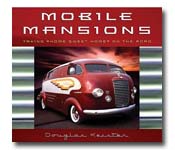|
Description :
|
The history of the Ultra Van can be traced to California RVer Dave Peterson. Peterson, who worked as an aircraft designer at Boeing and Beech. He had a Spartan trailer and also a boat. When he went on outdoor adventures, he had to choose between the comfort of the living space of the trailer and the recreational aspect of the boat, a dilemma that caused him to ponder ways to build a motorized trailer so he could tug his boat along behind it. The answer came in 1959 when General Motors introduced the 80–horsepower, 140-cubic-inch rear-engine-powered Corvair, an automobile that would later achieve a measure of fame as the subject of Ralph Nader’s 1965 book Unsafe at Any Speed. Employing his aircraft-design knowledge, Peterson used monocoque construction techniques of the aircraft industry to construct a body that needed neither frame nor chassis. The front and rear sections were made of fiberglass while the center section was made of an aluminum skin stretched over aluminum ribs. The low-slung design afforded a pleasing profile, plenty of interior space in its modestly proportioned 22-by-8-by-8-foot body and helped the Ultra Van attain a respectable 15 to 17 miles per gallon. Prior to this, monocoque construction techniques were used in trailers as early as the mid-1930s when sailplane pioneer Hawley Bowlus built his Bowlus-Teller trailers, but the techniques had never been used in any production motor coaches.
After renting a warehouse space in the fall of 1960, Peterson hired students from a local technical school. Four months later, the first unit, christened the Go-Home, poked its nose out the door. In all, Peterson and his students produced about fifteen of the Go-Homes, which sold for around $7,000. In 1963, the Prescolite Corporation, a manufacturer of light fixtures ordered some of the units (now dubbed the Travalon) to be used as mobile showrooms. By 1964, Peterson’s creation had attracted the attention of John Tillotson, a publisher in Kansas. Tillotson negotiated a license from Peterson and opened up shop in an unused aircraft hanger at an old Naval Base in Hutchinson, Kansas. He renamed the unit the Ultra Van.
The area around Hutchinson was home to many people who were trained in aircraft construction in World War II and was also close to Wichita, home of the Cessna Aircraft Corporation. Thus, craftsmen and managers, already familiar with monocoque fabrication techniques were the first employees of Ultra, Inc. By the end of 1966, eight Ultra Vans a month, with a price tag of $8,995, were gliding off the assembly line.
Ultra Vans never had staggering sales (less than four hundred in various configurations were built). Rumors, which eventually proved true, that Corvair would cease production, a price in 1968 that hovered around $10,000, and competition from other manufacturers spelled the end for the Ultra Van; the plant was closed in June 1970. In 1972 and 1973, founder Dave Peterson, attempting to revive the company, built five slightly longer units powered by an Oldsmobile Rocket V8 engine, but the 1973 energy crisis and subsequent gas shortages was too much for the tiny company to weather, and Peterson had to close up shop for good.
Thanks to the rustproof aluminum and fiberglass construction, many of the Ultra Vans are still on the road. In fact, the Ultra Van Motor Coach Club (UVMCC) can account for close to 250 of the 373 or so Ultra Vans believed to have been manufactured. This is a surprisingly high number, considering the last production model came off the assembly line in 1970. Ultra Van owners hold rallies, at which they proudly display their Ultra Van number, from time to time just like Airstream owners. The original prototype #101 was found in 1991 and was restored by club members. It is now on display in a museum in Tennessee.
Forrest Gist owns this 1968 Ultra Van #413. Photographed at the Deming Log Show Grounds, Bellingham, Washington.
|

